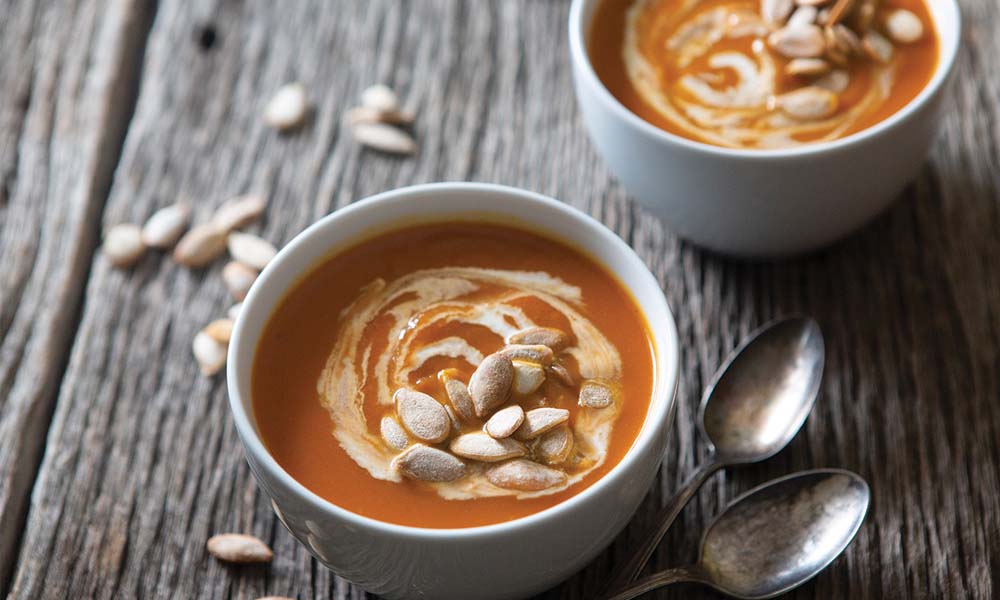
In a large bowl, toss together broccoli, diced apple, snap peas, dried cranberries, and sunflower seeds (holding back 1 tablespoon). In a food processor or with an immersion blender, blend the remaining ingredients until smooth and creamy. Pour dressing over salad, toss, and serve immediately.
Per serving: 179 calories, 14 grams fat (1.5 grams saturated fat), 0 milligrams cholesterol, 37 milligrams sodium, 13 grams total carbohydrates, 3 grams fiber, 2.5 grams protein.

In a small bowl, mix rice vinegar, fish sauce, soy sauce, sesame oil, sugar, and chili flakes. Set aside. Chop green onions, separating the whites from the greens. In a large skillet or wok, heat vegetable oil over medium heat. Toss in the whites of the green onion, shallot, ginger, and carrots. Stir, cooking about 5 minutes until golden and fragrant. Add garlic and stir another minute or so.
Make a well in the center of the skillet/wok and add the eggs with a tablespoon of water. Let them begin to set a bit, then scramble. Add cabbage and rice vinegar mixture. Stir and cook another few minutes, until fish scent mellows. Toss in the noodles, tofu (or chicken), lime juice, peanuts, and sesame seeds. Add a little water if the noodles seem dry, and cook until heated through. Top with onion greens and serve.
Per serving: 324 calories, 18 grams fat (3 grams saturated fat), 82 milligrams cholesterol, 970 milligrams sodium, 30 grams total carbohydrates, 4 grams fiber, 14 grams protein.

Preheat oven to 300 F. In a large bowl, stir together all ingredients to combine. Spread out in a thin layer on a greased, rimmed baking sheet (may require 2 baking sheets). Bake granola, stirring every 15 minutes until golden brown and dry, about 45 to 55 minutes, depending on how toasty you like your granola. Let cool on baking sheet for 10 minutes or so before storing in an airtight container at room temperature for up to two weeks.
Try a mix of your favorite chopped nuts, such as almonds, cashews, pecans, walnuts, and peanuts.
Per serving: 282 calories, 19 grams fat (4 grams saturated fat), 16 milligrams cholesterol, 108 milligrams sodium, 26 grams total carbohydrates, 5 grams fiber, 6.5 grams protein.

Preheat oven to 350 F. Cut pumpkin(s) in half. Scoop out the middle strands and seeds; discard the strands. Place the seeds in a small bowl, rinse with water, drain, and let dry out for a few minutes on paper towels. Pile seeds onto a cookie sheet. Drizzle with olive oil, sprinkle with salt, and toss to coat. Spread out in an even layer and bake 12 to 15 minutes, tossing halfway through, until they turn a golden-to-medium brown. Remove from oven and pour seeds into a small bowl. On the same cookie sheet, toss onion slices in olive oil. Spread in an even layer and roast in the oven for 20 to 30 minutes or until caramelized.
Meanwhile, brush interior of the pumpkin with olive oil and place flesh side down in a roasting pan. Bake 45 to 60 minutes on the bottom rack of the oven, or until the skin has started to brown and wrinkle and a fork easily pierces through the flesh. If you’re unsure it’s soft enough, keep cooking. Overcooking pumpkin for soup is better than undercooking it. If the skin starts to burn, loosely cover with foil.
Let pumpkin cool, then peel off the skin and remove the stem. Place remaining flesh in a food processor and blend until very smooth. Add the roasted red onion, vegetable broth, cayenne, nutmeg, ginger, and paprika and blend again. Pour soup into a saucepan and heat to desired temperature (or store soup in fridge until ready to eat.) Once hot, taste to adjust spices to your liking. Garnish with a swirl of heavy cream and the roasted pumpkin seeds.
There is 1 cup of cooked and mashed pumpkin in a pound of pumpkin. Best pumpkin varieties for soup: pie, Cinderella, Fairytale, Kabocha, Rouge Vif d’Etampes, Autumn Gold, and Buttercup.
Per serving: 150 calories, 3 grams fat (0.5 grams saturated fat), 0 milligrams cholesterol, 580 milligrams sodium, 29 grams total carbohydrates, 10 grams fiber, 3 grams protein.










